5.2: Radical Functions
( \newcommand{\kernel}{\mathrm{null}\,}\)
Evaluate a Radical Function
In this section we will extend our previous work with functions to include radicals. If a function is defined by a radical expression, we call it a radical function.
- The square root function is
- The cube root function is
A radical function is a function that is defined by a radical expression.
To evaluate a radical function, we find the value of
For the function
Solution:
a.
To evaluate
Simplify.
Take the square root.
b.
To evaluate
Simplify.
Since the square root of a negative number is not a real number, the function does not have a value at
For the function
- Answer
-
- no value at
For the function
- Answer
-
- no value at
We follow the same procedure to evaluate cube roots.
For the function
Solution:
a.
To evaluate
Simplify.
Take the cube root.
b.
To evaluate
Simplify.
Take the cube root.
For the function
- Answer
-
For the function
- Answer
-
The next example has fourth roots.
For the function
Solution:
a.
To evaluate
Simplify.
Take the fourth root.
b.
To evaluate
Simplify.
Since the fourth root of a negative number is not a real number, the function does not have a value at
For the function
- Answer
-
For the function
- Answer
-
Find the Domain of a Radical Function
To find the domain and range of radical functions, we use our properties of radicals. For a radical with an even index, we said the radicand had to be greater than or equal to zero as even roots of negative numbers are not real numbers. For an odd index, the radicand can be any real number. We restate the properties here for reference.
Properties of
When
When
So, to find the domain of a radical function with even index, we set the radicand to be greater than or equal to zero. For an odd index radical, the radicand can be any real number.
Domain of a Radical Function
When the index of the radical is even, the radicand must be greater than or equal to zero.
When the index of the radical is odd, the radicand can be any real number.
Find the domain of the function,
Solution:
Since the function,
Solve.
The domain of
Find the domain of the function,
- Answer
-
Find the domain of the function,
- Answer
-
Find the domain of the function,
Solution:
Solve the function,
The radicand cannot be zero since the numerator is not zero.
For
We set
Solve.
Also, since the radicand is a fraction, we must realize that the denominator cannot be zero.
We solve
Solve.
Putting this together we get the domain is
Find the domain of the function,
- Answer
-
Find the domain of the function,
- Answer
-
The next example involves a cube root and so will require different thinking.
Find the domain of the function,
Solution:
Since the function,
The domain of
Find the domain of the function,
- Answer
-
Find the domain of the function,
- Answer
-
Graph Radical Functions
Before we graph any radical function, we first find the domain of the function. For the function,
This tells us the domain is
Previously we used point plotting to graph the function,
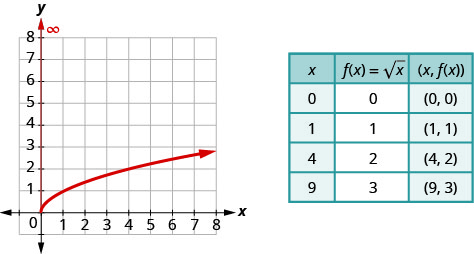
Once we see the graph, we can find the range of the function. The
For the function
- find the domain
- graph the function
- use the graph to determine the range
Solution:
- Since the radical has index
- To graph the function, we choose points in the interval
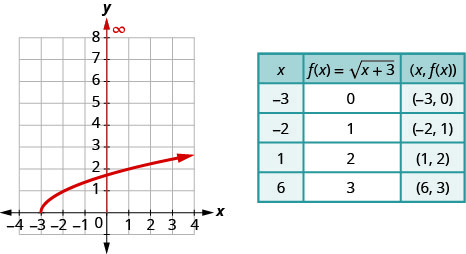
c. Looking at the graph, we see the
For the function
- find the domain
- graph the function
- use the graph to determine the range
- Answer
-
- domain:

Figure 8.7.3- range:
- domain:
For the function
- find the domain
- graph the function
- use the graph to determine the range
- Answer
-
- domain:

Figure 8.7.4- range:
- domain:
In our previous work graphing functions, we graphed
For the function,
- find the domain
- graph the function
- use the graph to determine the range
Solution:
a. Since the radical has index
b. To graph the function, we choose points in the interval
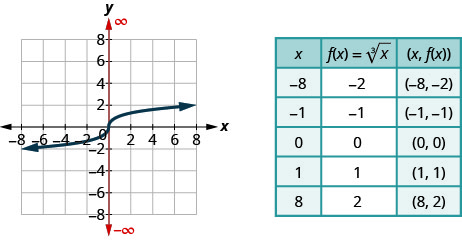
c. Looking at the graph, we see the
For the function
- find the domain
- graph the function
- use the graph to determine the range
- Answer
-
- domain:
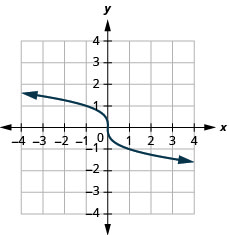
Figure 8.7.6- range:
- domain:
For the function
- find the domain
- graph the function
- use the graph to determine the range
- Answer
-
- domain:
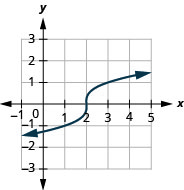
Figure 8.7.7- range:
- domain:
Access these online resources for additional instruction and practice with radical functions.
- Domain of a Radical Function
- Domain of a Radical Function 2
- Finding Domain of a Radical Function
Key Concepts
- Properties of
- When
- When
- When
- Domain of a Radical Function
- When the index of the radical is even, the radicand must be greater than or equal to zero.
- When the index of the radical is odd, the radicand can be any real number.
Glossary
- radical function
- A radical function is a function that is defined by a radical expression.

